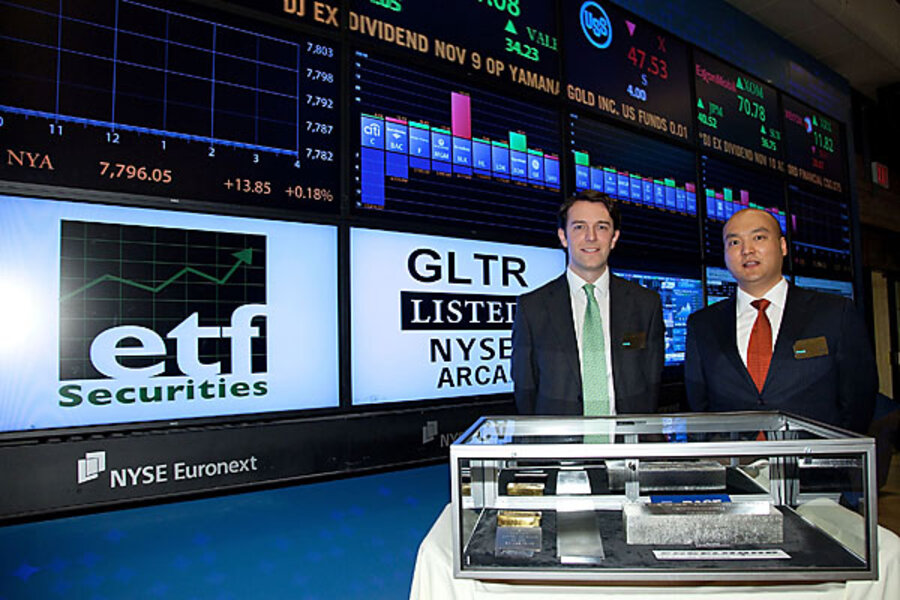ETFs: Exotic, far-flung offerings attract US investors
Loading...
| BOSTON
Inflation-wary investors worried about low returns in basic U.S. fixed-income and equity funds are flocking to some of the newest highly specialized exchange traded funds focused on exotic locations and products.
Investors are piling into new ETFs focused on precious metals, Indonesian stocks and global companies active in lithium mining, according to data compiled by Lipper, a unit of Thomson Reuters. Yield-hungry investors also favor new ETFs focused on master limited partnerships, emerging market debt and closed-end funds.
"The inflation story is driving investors toward companies and places leveraged to physical commodity prices," Morningstar analyst Scott Burns said. "And clearly, investors are gravitating toward higher yielding plays."
By contrast, some of the least-attractive new funds launched this year focused on broad U.S. equities markets. Some funds that tried to magnify their returns with futures contracts and, at the same time, invest in volatile niche markets also appear to have gained little interest.
The lack of flow to broad U.S. stock funds is further evidence of diminished faith in U.S. markets, according to some investors. "Normal domestic investing hasn't been attractive and will not be attractive on a relative basis for a while to come," said Roger Nusbaum, chief investment officer at Your Source Financial in Phoenix, Arizona.
QE2 FEEDS FUNDS
The ETF Securities Physical Palladium Shares Fund (PALL.P), the first of its kind in the U.S. market, stood at $578 million at the end of October, the most of any exchange-traded fund launched this year. A sister fund from privately owned ETF Securities devoted to platinum (PPLT.P) captured $570 million to rank second.
Investors are favoring ETFs that own physical commodities instead of funds that buy futures contracts because they track spot prices more closely, said Ron Rowland, president of Capital Cities Asset Management in Austin, Texas.
Flows into the precious metals funds have been fairly steady for most of the year, but trading volume has increased since the most recent meeting of the Federal Reserve's Open Market Committee, said Will Rhind, strategic director at ETF Securities.
"More quantitative easing will presumably be seen as a good thing for precious metals," he said, referring to the U.S. Federal Reserve's decision to stimulate the economy further by buying long-term debt in large amounts.
One of the largest new funds has attracted some controversy along with investor dollars. The Alps Alerian MLP ETF AMLP.O garnered $310 million by the end of October.
The fund, opened in August, invests in about two dozen master limited partnership equities. Partnership equities in the energy business carry some of the highest yields available in the U.S. stock market.
But Rowland says the fund's fees and operating expenses are eating into the returns investors expected. The underlying Alerian Index of MLPs gained 5.70 percent in September and 4.99 percent in October, while the ETF gained 3.42 percent and 3.17 percent for the same two months, he noted.
Still, none of the newest funds have approached the popularity of best-selling older funds. The Vanguard Emerging Markets Stock Fund (VWO.P) garnered $2.3 billion in net sales just in the month of September, for example, equaling the total assets of the five largest new funds.
The top new single-country funds opened in 2010 were the iShares MSCI Poland ETF and the iShares MSCI Indonesia ETF, both managed by BlackRock (BLK.N), according to Lipper data.
Both stock markets have been among the top performers this year. The MSCI Indonesia index has gained 36 percent so far this year and the Poland index is up 19 percent, better than the 16 percent gain in emerging markets overall.
Other popular new plays in emerging markets were Charles Schwab's (SCHW.N) Schwab Emerging Markets Equity ETF (SCHE.P) and the First Trust BICK Index fund (BICK.P), which invests in the equity markets of Brazil, India, China and South Korea.Schwab's fund, which did well despite successful pre-existing funds in the same area, is part of the broker's push into ETFs that began in November 2009. "Schwab's name is a well-known brand," said Tom Lydon, editor of the website ETFTrends.com. And "it's the cheapest emerging markets ETF."
But some investors criticized the combination of countries in the First Trust fund resulting in its memorable acronym. "BICK" was a twist on the "BRIC" theme popular last year, swapping South Korea in for Russia.
"The popularity of this would seem to have more to do with the catchy name than with the underlying rationale," said Charles Sizemore, who runs Sizemore Capital Management in Dallas. "Why Korea and not South Africa? Is 'BICSA' not marketable?"
WisdomTree's Emerging Market Local Debt Fund (ELD.P) was among the top picks for investors looking for yield and worried about the weakness of the U.S. dollar.
Among the least-popular new funds were several that focused on the broad U.S. equities market, including the Claymore/Wilshire 5000 Total Market ETF (WFVK.P), the Pax MSCI North America ESG Index ETF (NASI.P) and the iShares MSCI USA Index Fund (EUSA.P). None of the three had even $3 million in total assets at the end of October, Lipper said.
Some new funds that employed leverage to magnify returns and focused on volatile niches also found themselves bereft of investor dollars, including the ProShares UltraShort Nasdaq Biotech Fund (BIS.P) and the Direxion India Bear 2X Shares Fund (INDZ.P).
"There are limits to where people want leveraged ETFs," Morningstar's Burns said. "The more volatile the markets, the worse the long-term trading issues become."





